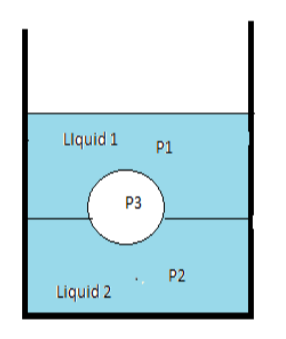
A jar filled with two non-mixing liquids 1 and 2 having densities ${\rho _1}$ and ${\rho _2}$, respectively. A solid ball, made of a material of density ${\rho _3}$, is dropped in the jar. It comes to equilibrium in the position shown in the figure. Which of the following is true ${\rho _{1,}}$ ${\rho _2}$ and ${\rho _3}$?

A) ${\rho _1} < {\rho _2} < {\rho _3}$
B) ${\rho _2} < {\rho _1} < {\rho _3}$
C) ${\rho _1} < {\rho _3} < {\rho _2}$
D) ${\rho _1} > {\rho _2} > {\rho _3}$
Answer
218.4k+ views
Hint: Density is a measure of mass per volume, the symbol most often used for density is $\rho $.
Then, formula used for density is:
$Density = \dfrac{{mass}}{{volume}}$
The more is mass, the more will be density.
Complete step by step solution:
Let us define density first and then we will determine the density of the liquids in increasing order. The density of a substance is its mass per unit volume. The density varies with temperature and pressure. On increasing the pressure on an object volume decreases and thus the density increases(as per the formula given in hint, density is inversely proportional to volume).
Density is an intensive property in that increasing the amount of as substance does not increase its density rather its mass increases.
When the object, substance or liquid has more mass then its density is also more.
As per the given diagram of the question, the liquid 2 which has more density will settle at the bottom then the object which is ball having density less than the liquid 2 will float on it. Similarly liquid 1 has density less than both the ball and liquid 2 will float on liquid 2 and the ball will sink in liquid 1.
Thus we can conclude that liquid 2 has maximum density, then ball and liquid 1.
Hence, option (C) is correct.
Note: Density of an object or substance determines whether or not an object will float on the surface of water . If the density of an object is lesser than the water than the object will float on the surface of water and if the density of an object is greater than the object will sink at the bottom of the water tank.
Then, formula used for density is:
$Density = \dfrac{{mass}}{{volume}}$
The more is mass, the more will be density.
Complete step by step solution:
Let us define density first and then we will determine the density of the liquids in increasing order. The density of a substance is its mass per unit volume. The density varies with temperature and pressure. On increasing the pressure on an object volume decreases and thus the density increases(as per the formula given in hint, density is inversely proportional to volume).
Density is an intensive property in that increasing the amount of as substance does not increase its density rather its mass increases.
When the object, substance or liquid has more mass then its density is also more.
As per the given diagram of the question, the liquid 2 which has more density will settle at the bottom then the object which is ball having density less than the liquid 2 will float on it. Similarly liquid 1 has density less than both the ball and liquid 2 will float on liquid 2 and the ball will sink in liquid 1.
Thus we can conclude that liquid 2 has maximum density, then ball and liquid 1.
Hence, option (C) is correct.
Note: Density of an object or substance determines whether or not an object will float on the surface of water . If the density of an object is lesser than the water than the object will float on the surface of water and if the density of an object is greater than the object will sink at the bottom of the water tank.
Recently Updated Pages
Chemical Properties of Hydrogen - Important Concepts for JEE Exam Preparation

JEE General Topics in Chemistry Important Concepts and Tips

JEE Atomic Structure and Chemical Bonding important Concepts and Tips

JEE Amino Acids and Peptides Important Concepts and Tips for Exam Preparation

JEE Extractive Metallurgy Important Concepts and Tips for Exam Preparation

Algebra Made Easy: Step-by-Step Guide for Students

Trending doubts
JEE Main 2026: Application Form Open, Exam Dates, Syllabus, Eligibility & Question Papers

Derivation of Equation of Trajectory Explained for Students

Hybridisation in Chemistry – Concept, Types & Applications

Understanding the Angle of Deviation in a Prism

Understanding Collisions: Types and Examples for Students

Understanding Atomic Structure for Beginners

Other Pages
JEE Advanced Marks vs Ranks 2025: Understanding Category-wise Qualifying Marks and Previous Year Cut-offs

Units And Measurements Class 11 Physics Chapter 1 CBSE Notes - 2025-26

NCERT Solutions For Class 11 Physics Chapter 8 Mechanical Properties Of Solids

Motion in a Straight Line Class 11 Physics Chapter 2 CBSE Notes - 2025-26

NCERT Solutions for Class 11 Physics Chapter 7 Gravitation 2025-26

How to Convert a Galvanometer into an Ammeter or Voltmeter




